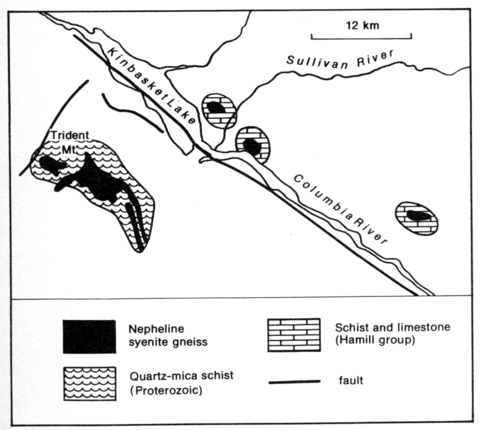stripes
Two occurrences of nepheline syenite are reported either side of the lower reaches of the Sullivan River, and a third possible occurrence some 13-15 km to the southeast. They lie conformably within mica schist of the Cambrian Hamill Group, which has calcareous horizons locally, but outcrops are poor and the full extent of the bodies is not known. The nepheline syenite is vaguely foliated and comprises plagioclase, microcline perthite, locally amphibole and biotite, and what is described as isotropic feldspathoid (Fyles, 1960, p. 103). The more southeasterly body is about 2 km x 300 m and cuts the Kinbasket limestone of the Hamill Group, into which it sends numerous tongues; there are many limestone inclusions. The syenite consists of microcline microperthite, nepheline, biotite and locally carbonate. Amphibole, epidote and garnet occur in coarse lenses at the east end of the mass.
CURRIE, K.L. 1976a. The alkaline rocks of Canada. Bulletin, Geological Survey of Canada, 239: 1-228.
FYLES, J.T. 1960. Geological reconnaissance of the Columbia River betwen Bluewater Creek and Mica Creek. Annual Report, British Columbia Department of Mines,(for 1959): 103-4.
WHEELER, J.O. 1965. Big Bend map-area, British Columbia. Paper, Geological Survey of Canada, 64-32: 1-37.

